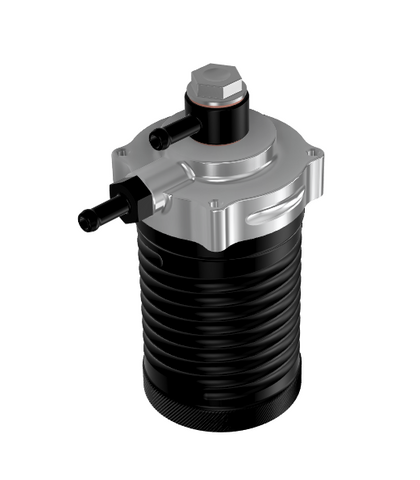
Previously in our AOS development posts, we hinted at some things we were testing to make our catch can a more effective and innovative product. Shown in the picture above is a test rig to simulate the functionality of a catch can. You may notice that this simulation has plumbing coming from BOTH the PCV and the CCV side. You may see some dual catch cans on the market, which pull from both the PCV and the CCV side in an effort to capture as much excess oil vapor from the intake air as possible. We wanted to test the possibility of routing both systems into one can in an effort to simplify the system and reduce cost.
However, in running our tests on the street under many different conditions, we found that even with both systems remaining closed and separate, there was a consistent and problematic fuel trim issue. This was most apparent at idle, where we were experiencing inconsistent short and long term fuel trims, and also a very slight, yet noticeable idle surge. Though, some of these issues may be able to be solved with tuning, or may not be considered critical to some, we strive to bring our customers the best products possible. Because of this, we will not be offering a dual port, combined PCV + CCV Air Oil Separator.
Now that we have finalized the direction in which we will head with this AOS, we are able to refine our design.








You may notice that the visual design of our catch can looks much different than it did in the previous blog post. This is because we have decided to switch manufacturing techniques to help expedite the production timeline and allow us to bring more production in-house. We redesigned the canister body to be billet 6061 aluminum, as well as accept a separate billet helix center section with an integrated spiral baffle plate. This design change, however, wasn’t just to offer more billet bling (although it does that pretty effectively now), the functionality has also been improved. Due to the divorced helix, as opposed to integrated with the previous design, we will have clearance between the edge of the helix and the interior walls of the can. This means that excess oil vapor, in addition to collecting on and running down the helix, now has the ability to sling outwards, collect on the walls, and drip down to the baffle plate. This maximizes the amount of oil separated from the intake air. We also added some slick external helical profiling and knurling on the out side of the can for aesthetics and function.
First article prototypes are currently in production so that we can begin final test fitting and data collection. This AOS should be available this summer - stay tuned for pricing expected release date!






Comments (6)
Still curious as to when this AOS is dropping!!
So, the last projected availability date was summer 22. It’s almost spring 23. Is there a new availability date yet?
Will the mounting bracket be compatible with your Flex Kit?
Please tell me you will offer this with brackets for the RDX as well!
This AOS should be available this summer – stay tuned for pricing expected release date!
I would be interested in knowing when this product is available for purchase.